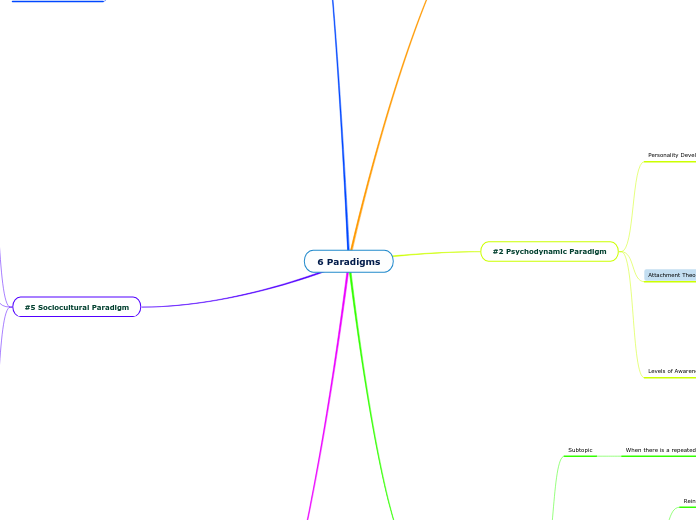6 Paradigms
#1 Biological Paradigm
DNA and Genes
Inheritance
From biological mother and father
Brain Structure
Amygdala
Cebral Cortex
Frontal Lobe
Physical Trauma/ Injury to the brain
FASD
Drugs or alcohol at a young age
Neurotransmitters(Chemicals)
Levels of Dopamine
Serotonin
GABA
Norepinephrine
#2 Psychodynamic Paradigm
Personality Development
ID
Present at birth
Provides the energy for basic biological motives
Pleasure Principle
Ego
Allows the ID to be satisfied but can understand the reality of a situation
Has selfish demands to satisfy the id
Superego
Morals and values
Restraints your behavior, thoughts and feeling
Attachment Theory
Secure Attachment
Ideal to have
Develop this with a healthy relationship with caregiver
Insecure Attachment
Not Ideal to have
Forms when caregiver is neglectful or not usually present
Levels of Awareness
1.Conscious
You are aware of
Memories, thoughts, feelings etc.
2.Preconscious
Feelings and memories that can be easily brought up to mind
3.Unconscious
Memories and traumatic events that can't be easily recalled
Has a significant influence on ones behavior
#3 Behavioral Paradigm
1.Classical Conditioning
When there is a repeated response to a certain event
Ex. If right before dinner someone rang a bell to let you know after a while you will be conditioned to think about food whenever you hear the sound of a bell and subconsciously believe you are getting food right after.
2.Operant conditioning
Reinforcement
Stickers
Positive feedback
Lollipop/ candy
Punishment
Time outs/ Time Ins
Taking away things one enjoys(electronics, etc)
Yelling and insulting
3. Social and Observational Learning
Role modeling
They will role model acceptable or unacceptable behaviour
Domestic Violence
Verbal, physical and
emotional abuse
Gentle and caring adult
#6 Two eyed seeing
Medicine Wheel
Holistic
Strategies
Spiritual activities
Connecting with the land
Participating in and
contributing to the
community
Two eyed seeing
One eye has strength
from indigenous knowledge
Traditional
Non hierarchal
Subtopic
Holistic
Interconnected
Other eye has strength from
Western knowledge
Hieratical
Objective &
Scientific
individualistic
Compartmentalized
Learning to use both together
can benefit everyone
#5 Sociocultural Paradigm
Culture
Ethnicity
Gender
Sex
Race
Holistic Model
(The whole Child)
Attachment issue
Friends/ Family
Illness
Religion
Mental Health/
Learning difficulties
Community
Environment
Dysfunctional
Environment Includes
Poverty
Gang Violence
Abuse
Racism
Ecological Model
Pattern of relationships to each level
in the Bronfenbrenner ecological model

#4 Cognitive Paradigm
Schema
Negative and positive
folder in the mind but some
children lack the positive
folder because of negative
experiences and comments
Children believe
what they are told about
themselves and the world
around them.
How people think(their POV)
from their:
Experiences
Thoughts
Perceptions
Beliefs
Attitudes
